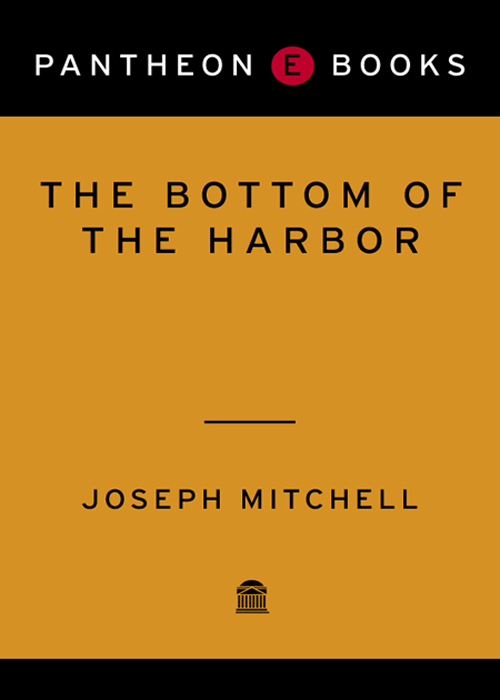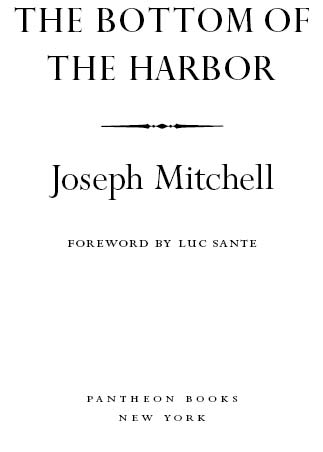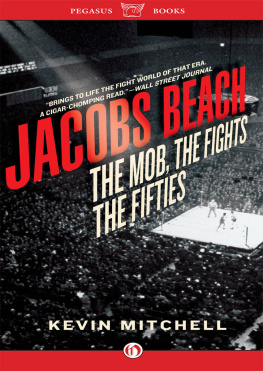

Contents
TO
NORA AND ELIZABETH MITCHELL
The worms crawl in,
The worms crawl out.
They eat your guts
And spit them out
Childrens Song
Foreword
When the stories in this book were first published, between 1944 and 1959, the harbor of New York was at its peak. The harbor and its many trades were an integral part of the citys daily fabric, and as such they passed largely unnoticed by most citizens. That is the usual fate of tradition, and it follows that hardly anyone foresaw its eclipse. Within a couple of decades of the books publication the better part of its subject matter had passed into history. Joseph Mitchell may not have thought that he was writing the harbors epitaph, but he was certainly aware of its fragility, all appearances to the contrary.
The transience of so many urban commonplaces that in their time seemed enduring to the point of immutabilityindeed, to the point where they escaped conscious noticewas a preoccupation of Mitchells. For all that he had come to New York from rural North Carolina, he had absorbed the citys fabric, both in its course over time and its daily apparatus, and he appreciated its changes and mourned its losses as few others did. When the neighborhood that contained Washington Marketthe great produce exchange that had ruled the citys diet since the eighteenth centurywas felled in the name of progress in the 1960s, he went around collecting bits of the structures: small fixtures that, fittingly, had gone unnoticed in their years of use but that he pressed into service as memorial markers.
But Mitchell should not be mistaken for a gravedigger. He was drawn to the harbor first of all because he was interested in people, in process, in specialized skills, in accreted time, in individual reckonings with tradition, in the annexes and alcoves and side rooms left out of the broader historical account. And he was drawn there by his sensesby the sound of names and the look of things and the odor of the sea and the taste of its fruits. In his pieces he walks through stories that bring together many of these fascinations; he watches people work, listens to their stories, savors them in the moment and at the same time regards them sub specie aeternitatis. An empty hotel above a bustling fish-market restaurant; the polluted remains of the once-flourishing oyster and clam beds in the harbor; the lives and exploits of the rats that come to the city aboard ships; the gentle decline of what began as a settlement of freed slaves in Staten Island; the labor of the captain of the biggest fishing fleet in the region; the unique practices of the shad fishermen at the foot of the Palisades in New Jerseyall of these are dense with color, flavor, humor, anecdotes, museum-quality details, and intimations of mortality.
Mitchell was a man of many interests, a brooder, a cataloger, an inveterate walker, and clearly one of the greatest listeners who ever lived. Just as the term journalist seems like a reductive label for his trade, so interview is utterly inadequate as a description of his chief working tool. He didnt use a recording device (not that such things were even available then) and didnt even ask many questions. By all accounts, he had a way of intently listening that by itself caused his subjects to keep talking. And then he reproduced what he had heard, with respect for his subjects and mindful of their rhythms of speech, but otherwise unconstrained by the slavish fidelity to minutiae that fact-checkers and legal counsel insist upon nowadaysand in the process turned all of his subjects into plain-spoken masters of American prose.
Mitchells verbal artistry is subtle, and it can be nearly invisible to the casual reader. This was by design. Few writers have been as self-effacing as Mitchell, whose reticence is one of the most striking contrasts between him and A. J. Lieblinghis friend, New Yorker colleague, and fellow enthusiast of New York City, plain cooking, and popular speechwho was the cheerful rotund extrovert to Mitchells thin melancholy introvert. Its subtlety was also a function of its deeply American aesthetic. Mitchell, whose favorite book was Ulysses, devised an equivalent in prose to the rigorous and deceptive simplicity of Walker Evanss photographs and Charles Sheelers paintings. Mitchells favorite device was the list, and his favorite conjunction was and: dust and lint and grit and sluts wool mussels and mud shrimp and conchs and crabs and sea worms and sea plants old anchors and worm wheels and buoys and bollards and propellors. Setting these objects side by side in a row has an effect that is both as plain as Shaker furniture and as expansive as a cinematic tracking shot. It also seems as functional as clapboard siding, although it is worth noting that across the page from the last of these cited lists, Mitchell records the message of a pulsating electric sign: SPRY FOR BAKING, SPRY FOR BAKING, SPRY FOR BAKING. There is nothing accidental about Mitchells rhythms.
In his most personal and revealing piece of writing, the introduction to the omnibus collection Up in the Old Hotel (1992), Mitchell mentions his affinity for the works of the Mexican graphic artist Jos Guadalupe Posada, famous for hilarious catastrophes and smartly turned-out antic skeletons, the salient feature being gallows humor. That aspect of his work is spelled out in this books epigraph: The worms crawl in, / The worms crawl out Had Mitchell lived in the Elizabethan era he might have been considered an antiquarian, like another kindred spirit, Robert Burton, the brooding and indefatigably listmaking author of The Anatomy of Melancholy. Like Burton, Mitchell meditates on graveyards and ruins, as well as doomed occupations and superannuated traditions, but what might at first appear to be a morbid streak turns out to be a homeopathic practice. Mitchell knew that an appreciation of death is necessary for an understanding of the regenerative cycle, the turning of the world. He could savor the perhaps galling fact that so many aspects of the world are taken for granted and only become truly visible at their twilight. The more he looked at the ends of things, the sharper his appetite for life, for sensual pleasures and creative disorder. This book of ostensibly journalistic feature stories turns out to hold at its core some of the fundamental questions of existence.
Luc Sante
Authors Note
The stories in this book first appeared in The New Yorker, but not in the order in which they are now arranged. The first story, Up in the Old Hotel, came out in the magazine under the title of The Cave in the issue of June 28, 1952; the second, The Bottom of the Harbor, came out in the issue of January 6, 1951; the third, The Rats on the Waterfront, came out under the title of Thirty-two Rats from Casablanca, in the issue of April 29, 1944; the fourth, Mr. Hunters Grave, came out in the issue of September 22, 1956; the fifth, Dragger Captain, came out in two parts in the issues of January 4 and January 11, 1947; and the sixth, The Rivermen, came out in the issue of April 4, 1959.
The people in all of the stories are connected in one way or another with the waterfront of New York City.
Up in the Old Hotel
Every now and then, seeking to rid my mind of thoughts of death and doom, I get up early and go down to Fulton Fish Market. I usually arrive around five-thirty, and take a walk through the two huge open-fronted market sheds, the Old Market and the New Market, whose fronts rest on South Street and whose backs rest on piles in the East River. At that time, a little while before the trading begins, the stands in the sheds are heaped high and spilling over with forty to sixty kinds of finfish and shellfish from the East Coast, the West Coast, the Gulf Coast, and half a dozen foreign countries. The smoky riverbank dawn, the racket the fishmongers make, the seaweedy smell, and the sight of this plentifulness always give me a feeling of well-being, and sometimes they elate me. I wander among the stands for an hour or so. Then I go into a cheerful market restaurant named Sloppy Louies and eat a big, inexpensive, invigorating breakfasta kippered herring and scrambled eggs, or a shad-roe omelet, or split sea scallops and bacon, or some other breakfast specialty of the place.
Next page







